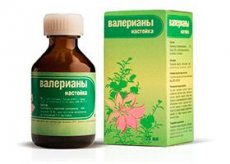Medical expert of the article
New publications
Preparations
Valerian
Last reviewed: 03.07.2025

All iLive content is medically reviewed or fact checked to ensure as much factual accuracy as possible.
We have strict sourcing guidelines and only link to reputable media sites, academic research institutions and, whenever possible, medically peer reviewed studies. Note that the numbers in parentheses ([1], [2], etc.) are clickable links to these studies.
If you feel that any of our content is inaccurate, out-of-date, or otherwise questionable, please select it and press Ctrl + Enter.

Valerian is a sedative and anxiolytic herbal remedy based on the roots and rhizomes of Valeriana officinalis. Valerian is a herb whose root contains active components including valepotriates and spicy odiferous oils.
Indications Valerian
Valerian is used as a sedative and sleep aid and is very popular in Europe.
Indications for which the use of Valerian and all preparations based on it is recommended include functional disorders of the central nervous system and cardiovascular system:
- nervous overexcitement, increased emotional excitability and anxiety;
- neurotic conditions, including those with spasms of the heart vessels and tachycardia;
- sleep disorders (difficulty falling asleep, insomnia);
- neurocirculatory dystonia.
The drug also has antispasmodic and muscle relaxant properties and can be used for gastrointestinal spasms of various etiologies (in particular, those associated with spastic colitis), as an anticonvulsant for epilepsy, and for bronchospasms (histamine- and antigen-induced).
Pharmacodynamics
The mechanism of sedative action of Valerian is based on the biochemical properties of active substances contained in the roots and rhizomes of medicinal valerian (Rhizoma cum radicibus Valeuianae): mono- and triterpenes, iridoid triesters (valepotriates), flavonoids (hesperidin, 6-methyl-apigenin, linarin), as well as alkaloids (valerianin, valerine, actinidin, chatinin, isovaleramide).
The roots contain essential oil, which contains biologically active sesquiterpenes (valerianic and isovaleric acids), borneol, camphene, pinene, and pyrryl-alpha-methyl ketone.
The alkaloids of Valeriana officinalis have a structural similarity with psychoactive anxiolytic substances of the benzodiazepine group and interact with cellular receptors of GABA (gamma-aminobutyric acid), serotonin and adenosine, which reduces the excitability of peripheral neurotransmitters and helps to increase the resistance of CNS neurons to excitation.
The antispasmodic effect of valerian preparations is associated with their ability to reduce the activity of the pituitary hormone vasopressin.
 [ 8 ]
[ 8 ]
Dosing and administration
Valerian tablets are taken orally (before meals) - one tablet twice a day. In cases of problems with falling asleep - one or two tablets are taken half an hour before bedtime.
The tincture is taken after meals - 20-30 drops, and teenagers over 12 years old - 15 drops. The frequency of administration and duration of Valerian use is determined by the attending physician.
Use Valerian during pregnancy
Since there is insufficient information regarding the safety of Valerian for pregnant women, it is not recommended to use this drug during pregnancy and lactation.
Side effects Valerian
Valerian may prolong the effects of other sedatives (eg, barbiturates) and may impair driving or other activities that require caution.
The use of Valerian may be accompanied by side effects in the form of increased sleepiness, lethargy and a feeling of general depression. In some cases, this drug can cause headaches and night terrors.
Valerian can reduce muscle tone, physical performance and dull attention (which should be kept in mind when driving vehicles and operating machinery).
 [ 14 ]
[ 14 ]
Overdose
Exceeding the dose of Valerian increases its side effects and also causes a feeling of discomfort in the stomach; nausea and vomiting may occur. Overdose requires discontinuation of the drug and symptomatic treatment.
 [ 20 ]
[ 20 ]
Interactions with other drugs
Attention!
To simplify the perception of information, this instruction for use of the drug "Valerian" translated and presented in a special form on the basis of the official instructions for medical use of the drug. Before use read the annotation that came directly to medicines.
Description provided for informational purposes and is not a guide to self-healing. The need for this drug, the purpose of the treatment regimen, methods and dose of the drug is determined solely by the attending physician. Self-medication is dangerous for your health.

